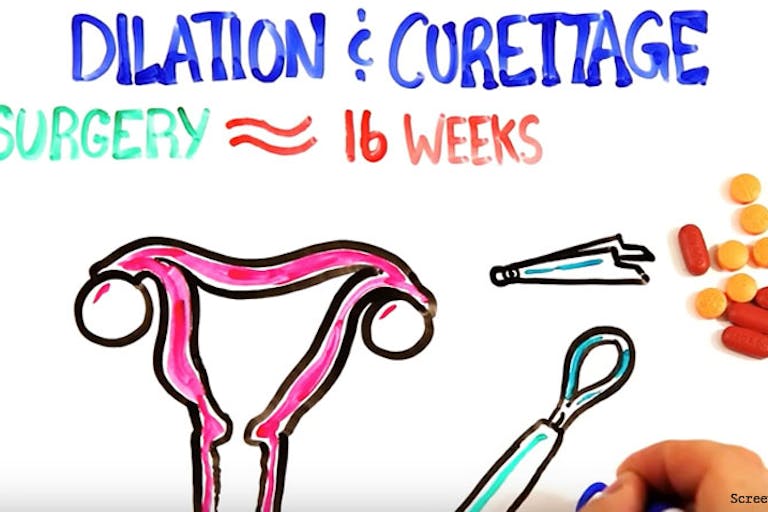
Full term 'miracle' baby born after 'unprecedented' ectopic pregnancy
Bridget Sielicki
·
Science video series smuggles abortion lies in nonpartisan packaging
Lifehacker used to be one of the only sites in the former Gawker network free of odious political propaganda (with Jezebel of course being the worst), instead simply providing a variety of useful information on technology, health, productivity, and a range of other areas.
Sadly, on Monday they ran a piece promoting a video (below) by ASAP Science, and while it’s billed as simply informative—it supposedly “corrects some misconceptions” and “myths” surrounding abortion “you may have picked up along the way”—from the start, it obscures more than it illuminates, then goes on to perpetuate myths, and by the end it drops the veneer of impartial education in favor of open pro-abortion advocacy:

The first point of interest is the statement that “92% of legal US abortions take place within the first 13 weeks of gestation.” While at first glance that sounds like we should infer later-term abortions are a small issue, note well that eight percent of one million (the approximate annual number of abortions in the U.S.) is still eighty thousand children killed—almost nine times the total number of children from age 1-14 who die annually, and five times the total number of murders in 2015. Does that sound like a big deal to you?
That said, ASAP Science missed a few scientific facts that would have been more helpful in developing an informed opinion on abortion, like that a heartbeat begins at 5 weeks, reaction to stimuli is observed as early as 7.5 weeks, and brainwaves are measurable by week 8.5. So if we’re supposed to infer that killing fetuses younger than 13 weeks is less consequential than killing older, more “baby-like” fetuses, the reality is that abortion’s victims already possess some of living humans’ most defining characteristics beforehand.
Next, the video describes several abortion procedures in a mostly neutral way, with the exception of one major recurring euphemism: “remove the contents of the uterus.” Hmm, I wonder what “the contents” are? Undifferentiated cells? Phlegm? Pez?
Moreover, the emptying isn’t the objectionable part of abortion. (Childbirth also “removes the contents of the uterus.”) What happens to “the contents” during the removal? ASAP Science doesn’t say. Because admitting that they’re talking about the induced death of a living human being would undermine the video’s gentle marker-and-whiteboard aesthetic and tip viewers off to the fact that what they’re trying to sanitize isn’t so sanitary after all.
The euphemism “remove” is even more objectionable in the video’s description of D&C (dilation & curettage) and D&E (dilation & evacuation, AKA dismemberment) abortions. It describes curettes, forceps, and vacuum aspiration as being used for removal, when in reality that “removal” consists of tearing the fetus’s body apart. For a more honest and productive video on the subject than ASAP Science’s, check out this video, narrated by former abortionist Dr. Anthony Levatino:

That’s it for anything with even the pretence of science; the rest of ASAP “Science’s” presentation is pure propagandizing:
The decision to have an abortion after 24 weeks is extremely rare and often due to severe fetal anomalies.
First, “rare” here still means 13,000 children killed per year. Second, the conclusion that they’re mostly for “severe fetal anomalies” isn’t where the evidence would have lead a truly objective project. Last year, FactCheck.org concluded, “there is no definitive information as to how many of those abortions are due to medical necessity,” but there is anecdotal evidence that the truth is the opposite—according to D&X (partial-birth) abortion creator Martin Haskell and late-term abortionist George Tiller, only one in five, or fewer, late-term abortions are done for complications to either mother or child’s health.
Article continues below
Dear Reader,
Have you ever wanted to share the miracle of human development with little ones? Live Action is proud to present the "Baby Olivia" board book, which presents the content of Live Action's "Baby Olivia" fetal development video in a fun, new format. It's perfect for helping little minds understand the complex and beautiful process of human development in the womb.
Receive our brand new Baby Olivia board book when you give a one-time gift of $30 or more (or begin a new monthly gift of $15 or more).
The video next reinforces myths about abortion’s safety, claiming “the risk of death associated with childbirth is 14 times higher in women than that of an abortion,” and that abortion’s links to breast cancer, difficulties in conceiving later, and future pregnancy complications “have been refuted by extensive medical research.” Longtime Live Action readers know we’ve debunked these lies on numerous occasions; you can get the facts here. The video goes on:
Laws that limit a woman’s access to an abortion or make abortion illegal do not reduce the number of abortions. Countries where abortions are illegal have roughly the same number of abortions; what changes instead is the incidence of unsafe abortions.
The citation for this claim is an old New York Times piece from 2007, which was also the basis for an infamous bit of pro-abortion propaganda Live Action addressed back in 2012, including Kristi Burton Brown’s rebuttal to this particular claim. Citing Poland and Ireland as examples, she showed that abortion prohibition did significantly cut those countries’ abortion rates, and that varying medical standards, not prohibition, was the real culprit behind abortion deaths. Another of the video’s claims:
A 2011 study did find that state level anti-abortion laws and Texas correlated with the lower abortion rates in the state, but these results did not account for women traveling to other states with less restrictive laws to receive a procedure.
The study they’re referencing was authored by none other than pro-life research extraordinaire Michael New, who Live Action regulars know is not one to overlook relevant variables. And while he only mentioned out-of-state travel in passing in this particular analysis, he did mention it—as part of explaining the variables he incorporated, he noted that “reductions in the number of abortion providers would increase the monetary and travel costs involved with obtaining an abortion.”
That’s a helpful reminder that pro-aborts can’t keep their story straight: is traveling hundreds of miles to get an abortion so expensive that it makes abortion restrictions cruel and unusual punishment, or so cheap and easy that pro-life states might as well not bother? In any event, ASAP Science’s point is a red herring because abortion laws varying from state to state isn’t the pro-life movement’s end goal anyway; nationwide abolition is.
More importantly, as Secular Pro-Life points out:
The better method is to compare abortion numbers in the same country both before and after laws are passed. Pro-choicers never do this, because the results don’t go their way. As the Washington Post (not known for supporting the right to life) acknowledges, the U.S. abortion rate increased significantly following Roe v. Wade.
The video closes with the obligatory ode to “sex education and access to contraceptive methods” as the real silver bullets to reduce abortions (no and no), dropping the educational mask entirely by declaring “access to legal abortions make women safer and healthier,” and advertising another of their videos, which makes the case that Plan B isn’t abortive based on the following statement, which is amazing for all the wrong reasons:
No studies have shown an effect from emergency contraception if fertilization has already occurred. It does not stop implantation from happening nor does it have any effect after implantation has occurred.
No studies? That’s funny, because in one of the most detailed examinations of the question around, Dr. Donna Harrison cited quite a few studies showing that it most certainly can kill embryos:
If LNG is given one to two days before the egg is due to be released, then egg release is not reliably prevented (see here, here, and here). In fact, in several studies of women who received LNG as an emergency contraceptive during the time immediately before ovulation, ovulations were documented but no pregnancies occurred (see here and here) […]
When ovulation does occur after LNG has been given, most of those ovulations show luteal-phase defect (see here, here, here, here, here, and here).
That’s the term for when the ovary does not produce enough progesterone to allow the embryo to survive. If the LH surge is blunted — that’s an interference at step 3, above – then the ovary will release the egg, which can be fertilized but not produce enough progesterone for steps 6, 7, and 8. So, the embryo formed would not survive long enough to produce a positive pregnancy test.
In the final analysis, denying the very existence of so much real scientific research is the perfect encapsulation of the abortion lobby’s phony monopoly on science. Unfortunately, as long as it continues to infiltrate the culture under the guise of impartial education, it will continue to plague our efforts.
Live Action News is pro-life news and commentary from a pro-life perspective.
Contact editor@liveaction.org for questions, corrections, or if you are seeking permission to reprint any Live Action News content.
Guest Articles: To submit a guest article to Live Action News, email editor@liveaction.org with an attached Word document of 800-1000 words. Please also attach any photos relevant to your submission if applicable. If your submission is accepted for publication, you will be notified within three weeks. Guest articles are not compensated (see our Open License Agreement). Thank you for your interest in Live Action News!

Bridget Sielicki
·
Issues
Nancy Flanders
·
Politics
Bridget Sielicki
·
Issues
Sheena Rodriguez
·
Guest Column
Right to Life UK
·
Issues
Bridget Sielicki
·
Guest Column
Calvin Freiburger
·
Abortion Pill Reversal
Calvin Freiburger
·
Guest Column
Calvin Freiburger
·
Abortion Pill Reversal
Calvin Freiburger
·
Activism
Calvin Freiburger
·